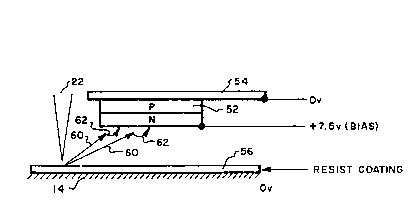Some of the information on this Web page has been provided by external sources. The Government of Canada is not responsible for the accuracy, reliability or currency of the information supplied by external sources. Users wishing to rely upon this information should consult directly with the source of the information. Content provided by external sources is not subject to official languages, privacy and accessibility requirements.
Any discrepancies in the text and image of the Claims and Abstract are due to differing posting times. Text of the Claims and Abstract are posted:
| (12) Patent: | (11) CA 2022251 |
|---|---|
| (54) English Title: | ELECTRON-DETECTOR DIODE BIASSING SCHEME FOR IMPROVED WRITING BY AN ELECTRON BEAM LITHOGRAPHY MACHINE |
| (54) French Title: | METHODE DE POLARISATION DE DIODES DE DETECTION D'ELECTRONS AMELIORANT L'ECRITURE DANS UNE MACHINE LITHOGRAPHIQUE A FAISCEAU ELECTRONIQUE |
| Status: | Expired and beyond the Period of Reversal |
| (51) International Patent Classification (IPC): |
|
|---|---|
| (72) Inventors : |
|
| (73) Owners : |
|
| (71) Applicants : |
|
| (74) Agent: | OSLER, HOSKIN & HARCOURT LLP |
| (74) Associate agent: | |
| (45) Issued: | 1998-07-07 |
| (22) Filed Date: | 1990-07-30 |
| (41) Open to Public Inspection: | 1991-02-09 |
| Examination requested: | 1994-10-27 |
| Availability of licence: | N/A |
| Dedicated to the Public: | N/A |
| (25) Language of filing: | English |
| Patent Cooperation Treaty (PCT): | No |
|---|
| (30) Application Priority Data: | ||||||
|---|---|---|---|---|---|---|
|
Disclosed is a biassing scheme for a beam position
location apparatus (50) which comprises electron detector
diodes (52) in an electron beam lithography machine (10)
such that the detector diodes (52) deposit fewer
secondary electrons (62) on a substrate (16) being
processed by the electron beam (22) and thus reduce or
eliminate any charge buildup on said substrate which
deflect the electron beam (22) causing pattern
distortion.
L'invention est une méthode de polarisation pour un dispositif de positionnement de faisceaux (50) pour machine de lithographique à faisceau électronique (10) qui comprend des diodes de détection d'électrons (52) qui déposent moins d'électrons secondaires (62) sur le substrat (16) traité par le faisceau électronique (22), ce qui réduit ou élimine les charges d'électricité statique sur ce substrat qui produisent des distorsions en faisant dévier le faisceau électronique (22).
Note: Claims are shown in the official language in which they were submitted.
Note: Descriptions are shown in the official language in which they were submitted.

2024-08-01:As part of the Next Generation Patents (NGP) transition, the Canadian Patents Database (CPD) now contains a more detailed Event History, which replicates the Event Log of our new back-office solution.
Please note that "Inactive:" events refers to events no longer in use in our new back-office solution.
For a clearer understanding of the status of the application/patent presented on this page, the site Disclaimer , as well as the definitions for Patent , Event History , Maintenance Fee and Payment History should be consulted.
| Description | Date |
|---|---|
| Inactive: IPC from MCD | 2006-03-11 |
| Inactive: IPC from MCD | 2006-03-11 |
| Time Limit for Reversal Expired | 2003-07-30 |
| Letter Sent | 2002-07-30 |
| Grant by Issuance | 1998-07-07 |
| Letter Sent | 1998-04-14 |
| Amendment After Allowance Requirements Determined Compliant | 1998-04-14 |
| Amendment After Allowance (AAA) Received | 1998-02-27 |
| Pre-grant | 1998-02-27 |
| Inactive: Amendment after Allowance Fee Processed | 1998-02-27 |
| Inactive: Final fee received | 1998-02-27 |
| Notice of Allowance is Issued | 1998-01-02 |
| Notice of Allowance is Issued | 1998-01-02 |
| Letter Sent | 1998-01-02 |
| Inactive: Status info is complete as of Log entry date | 1997-12-29 |
| Inactive: Application prosecuted on TS as of Log entry date | 1997-12-29 |
| Inactive: First IPC assigned | 1997-12-12 |
| Inactive: IPC assigned | 1997-12-12 |
| Inactive: Approved for allowance (AFA) | 1997-12-12 |
| Inactive: Delete abandonment | 1997-12-12 |
| Inactive: IPC removed | 1997-12-12 |
| Inactive: Abandon-RFE+Late fee unpaid-Correspondence sent | 1997-07-30 |
| All Requirements for Examination Determined Compliant | 1994-10-27 |
| Request for Examination Requirements Determined Compliant | 1994-10-27 |
| Application Published (Open to Public Inspection) | 1991-02-09 |
There is no abandonment history.
The last payment was received on 1997-07-28
Note : If the full payment has not been received on or before the date indicated, a further fee may be required which may be one of the following
Please refer to the CIPO Patent Fees web page to see all current fee amounts.
| Fee Type | Anniversary Year | Due Date | Paid Date |
|---|---|---|---|
| Request for examination - standard | 1994-10-27 | ||
| MF (application, 7th anniv.) - standard | 07 | 1997-07-30 | 1997-07-28 |
| Final fee - standard | 1998-02-27 | ||
| 1998-02-27 | |||
| MF (patent, 8th anniv.) - standard | 1998-07-30 | 1998-07-21 | |
| MF (patent, 9th anniv.) - standard | 1999-07-30 | 1999-06-30 | |
| MF (patent, 10th anniv.) - standard | 2000-07-31 | 2000-07-04 | |
| MF (patent, 11th anniv.) - standard | 2001-07-30 | 2001-07-05 |
Note: Records showing the ownership history in alphabetical order.
| Current Owners on Record |
|---|
| ETEC SYSTEMS, INC. |
| Past Owners on Record |
|---|
| WILLIAM JAY DEVORE |